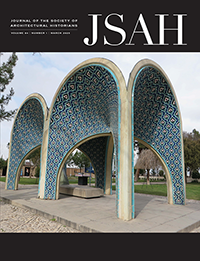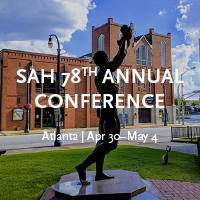This roundtable asks, how might we take up a historical lens to the spatial and architectural dimensions of trans experiences? As some historians have argued, transgender history began long before it was brought into public awareness. Scholars have uncovered
pre- and early modern histories of persons challenging gender binaries (examples include Roman emperor Elagabalus and eighteenth-century French diplomat Chevalier d'Éon), emphasizing the need to describe these figures as transgender even though
this term was unknown back then. When analyzing the lives and practices of gender-variant monks in Byzantium in his book Byzantine Intersectionality (2020), art historian Roland Betancourt emphasizes that recognizing these individuals as
transgender is crucial as one of the goals of writing such histories is to counter the prevalent assumption “that trans and nonbinary subjects are a modern invention.” Such historiographical approaches can be brought to architecture as
well. While efforts to acknowledge trans experiences may be relatively new among architects and theorists, people who challenged gender binaries existed as users and makers of spaces long before their perspectives were deemed worthy of academic attention.
Cisnormativity—the outlook according to which cisgender identity is the default norm while other forms of gender identity are seen as deviations from that norm—is deeply ingrained in modern Western social and spatial organization. For transgender
individuals, defined as “people who move away from the gender they were assigned at birth, people who cross over (trans-) the boundaries constructed by their culture to define and contain that gender” (Susan Stryker, Transgender History,
2017), cisnormative spaces are frequently experienced as oppressive and hostile. Until recently, trans experiences have not been acknowledged in discourses around architecture. Gender theorist Jack Halberstam has identified “an emergent architectural
turn in transgender studies” (Jack Halberstam, “Unbuilding Gender,” 2018). However, this has not been mirrored by a transgender turn in architecture studies.
This roundtable makes space for architectural histories that center trans experiences, especially those written from the perspective of trans individuals. It seeks to elucidate what makes a space trans across diverse historical and geographic contexts,
how trans and gender non-conforming actors have historically negotiated cis-gendered spaces, and how trans experiences in architectural history can reframe normative social, cultural, and design practices and ontological categories.
Submission Guidelines
A JSAH Roundtable consists of a series of short essays, each of approximately 1000 words, that will be collectively published in the place of a single article in an issue of JSAH. This format provides an opportunity for a range of contributors to explore
new research directions through a variety of lenses, alongside the traditional full-length articles that are the JSAH mainstay. We welcome submissions by individuals at different career stages (including independent scholars) and different types of
institutions (universities, government agencies, museums) that are diverse in their gender, racial, and national composition. To propose an essay for the roundtable, please submit a CV and a one-page abstract for review by roundtable editor Lidia
Klein to:
lklein7@uncc.edu.
Deadline for proposal submissions: 30 October 2024.


